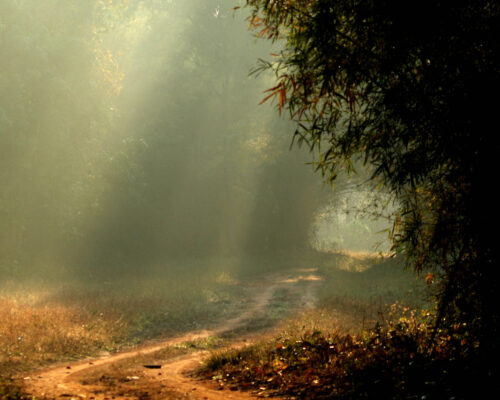A thermal power plant in Maharashtra’s Chandrapur district has become home to a group of tigers. The abundance of cattle and the dense tree cover around the huge plant have provided a suitable environment for the breeding of big cats. Tigers are known for living in dense forest areas, away from human settlements, and unlike the other big cats, leopards, that are quite comfortable living in human-dominated habitats and in the proximity of urban areas. But a group of tigers in central India has shown a difference in behavior, and are becoming more comfortable in a highly urban setting.
Around five tigers in the Chandrapur district of north-eastern Maharashtra have made a thermal power station area their permanent home over the past four or five years and are highly comfortable in living in this region. These tigers not only roam freely inside the power station area, which has about 10,000 people, but also frequent the residential areas in the adjoining Chandrapur city that has a human population of over 500,000 which is a considerable number.
While no explanatory research has been carried out defining such tigers as ‘urban tigers’, there is anecdotal evidence that indicates that these tigers in the Chandrapur landscape, are less averse to living close to human settlements and do not fear humans. Chandrapur district has around 160 to 170 tigers and half of them have their habitats outside the protected areas. There have been changes in the behavior patterns of tigers in the past few years, which may have been induced by both natural as well as external factors.

The Chandrapur Super Thermal Power Station is connected to the famous Tadoba-Andhari Tiger Reserve through a corridor of coal mines that are thickly covered with Prosopis plant species. Adequate prey base in the form of stray cattle and wild boars, substantial tree cover, and a perennial nullah passing through the power plant help meet all the basic needs of these resident tigers, have been pointed out by experts. The power plant is built on 1,117 hectares of land, the staff quarters on 340 hectares while 2,665 hectares are earmarked for the ash dump. Our resort in Tadoba is really close to the power plant. Our resort in Tadoba is situated near the Tadoba Andhari Tiger Reserve.
You can relax and rejuvenate at our resort in Tadoba while you enjoy safaris and tiger sightings at the tiger reserve during the daytime. Tigers would come to the massive thermal power station from the tiger reserve earlier as well. However, it would always be a fleeting visit, which would often go unnoticed by the people of the surrounding areas. Now, tigers have made the power plant their habitat, staying alongside the people residing there with ease.
While factors such as the increasing number of tigers and shrinking forest areas are some of the major drivers, some behavioral changes in tigers may also be responsible for these developments, quoted VS Ramarao, Chief Conservator of Forest of Chandrapur Circle, who has recently been transferred to Yavatmal in the same capacity.
“We have observed the food habits and the living habits of tigers have changed,” he was quoted as saying. “In the power plant, stray cattle and wild boars take care of the food while Prosopis trees offer them great cover to hide.”
“These tigers are trying to adjust themselves in the new conditions as there is hardly any space for them to live in the protected areas,” he said.
There are estimated to be 2,000 to 4,000 stray cattle who reside inside the power plant area and their number has grown substantially, with good availability of grass and fodder. A tigress brought up her three cubs on an ash bund embankment a few years ago only. It is speculated that these cubs may have been born in the power plant area itself and are expected to live in degraded forests or non-forested areas throughout their life.
Bilal Habib, Wildlife Biologist with the Wildlife Institute of India, said the tigers that were born or grew up in the power plant, which is a non-forest area, would tend to live in similar conditions wherever they migrate to, due to their natal memory.
“Technically, we may not call the tigers in the power station area ‘urban tigers’,” he said.
“However, the mental setup of such tigers would be influenced by where they were born and grew up respectively.” “Due to their natal memory, such animals would consider areas like the power plant as their habitat,” he said.
There are some examples that also reflect the effects of natal memory such as one tiger moved out of the power plant about three years ago and traveled to neighboring districts of Yavatmal, Wardha, and Nagpur. It preferred to stay in the non-forest areas during its entire journey and finally landed up in Satpura Thermal Power Station in Sarni in Madhya Pradesh’s Betul district.
Survival is a major driver for the tigers adapting to the conditions that may not be ideally suitable for their livelihood, quoted Nitin Desai, central India director of Wildlife Protection Society of India.
“Protected areas are full and they cannot hold any more tigers and so, additional tigers are spilling over to the degraded forests, which may not be ecologically rich for them and are dotted with human presence,” he said. “Yet, the tigers are alive and kicking in such areas.” The behavioral changes are not happening due to genetic changes but local adaptation tactics added Desai.
Degraded forests or territorial forests that were generally used as sinks by tigers, preferably by migrating ones, now are becoming high breeding grounds. Regular monitoring of such tigers has shown that they have no qualms about living in areas with thorny shrubs or ash bunds, said Bandu Dhotre, Honorary Wildlife Warden of Chandrapur district.
People living in the staff quarters in the power plant said they did not bother about the tiger sightings a couple of years ago but the fact that tigers are making the thermal power station their habitat has them quite worried now. The abundance of cattle and the dense cover of Prosopis trees, which grow like big shrubs, have provided a suitable environment for the development of breeding grounds in the immense power plant.
Habib, though, cautioned against letting the power plant turn into a complete breeding ground. “If there are going to be such urban tigers, there will be more and more human-animal conflict between the animals and humans,” he asserted. “We need a policy, a thought process about what is to be done with tigers in human-dominated areas.”
The Maharashtra government is contemplating mass-translocation of tigers from the power plant and other areas where human-tiger conflict is expected to flare up in the near future, to other nearby forests. However, there is a note of extreme caution from some conservationists. They said the space that falls vacant after the translocation of existing tigers would be occupied by new tigers who would adapt to these changes.



